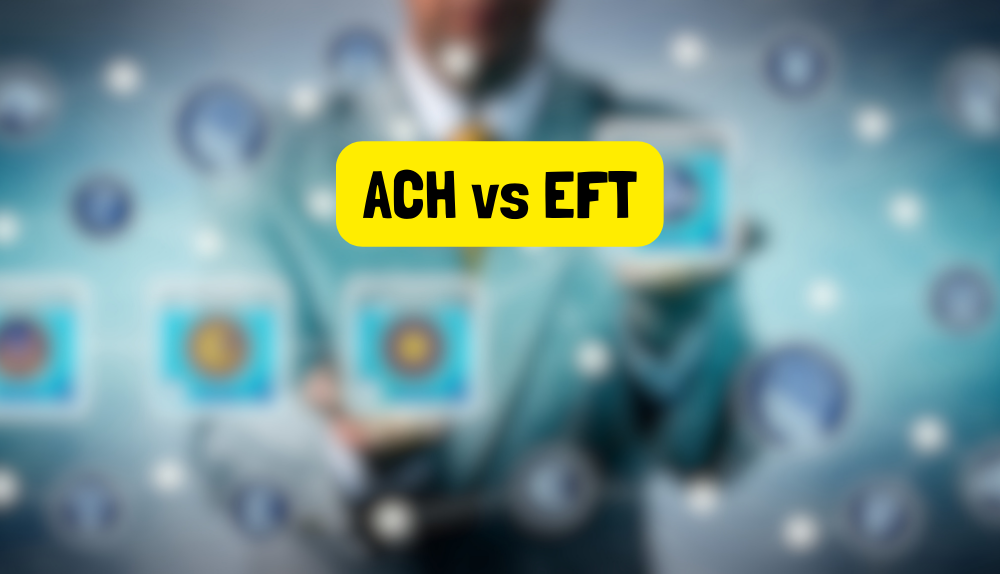
ACH vs EFT: What Is The Difference?
- 31st May, 2023
- | By max
- | Uncategorized
Electronic Funds Transfer (EFT) and Automated Clearing House (ACH) transactions are integral components in today’s digital financial landscape, facilitating seamless and efficient monetary exchanges. While these terms are often used interchangeably, understanding their nuanced differences is crucial for anyone engaging with financial operations, whether for personal banking or business transactions.
This exploration into ACH vs EFT will delve into their functionalities, distinguish their unique characteristics, and illuminate their significance in our increasingly interconnected global economy. Consequently, this knowledge can aid in more informed financial decision-making and streamline financial management professionally.
ACH vs EFT
Definition and Explanation of EFT
Electronic Funds Transfer (EFT) transfers money from one bank account to another without any physical money changing hands. EFTs are becoming increasingly common as they offer convenience, speed, and broad utility for personal and commercial transactions.
Vantage Market Research predicts a promising Global Electronic Funds Transfer Market future. Between 2022 and 2028, they expect this market to expand significantly, projecting it to achieve revenue of USD 103.2 Billion. This growth describes a Compound Annual Growth Rate (CAGR) of 8.70%, underscoring the dynamic nature of this sector.
The Mechanics of How EFT Works
At its core, EFT exchanges financial data between banks using secure electronic transmission methods. When an EFT transaction is initiated, the relevant financial information, such as the sender and receiver’s bank account information and the amount to be transferred, is sent electronically over a network. This data is then processed, and the corresponding funds are moved between accounts, all without manual intervention or paper-based processes.
Types of EFTs
Debit Cards: These cards are linked directly to a bank account and allow the cardholder to make payments or withdraw cash up to the balance in the account. Debit card transactions are a form of EFT as the funds are transferred electronically when a transaction is made.
ATMs: Automated Teller Machines (ATMs) facilitate EFTs by enabling users to withdraw cash, deposit checks, or transfer funds between linked accounts, all through electronic means.
Direct Deposit: This is an EFT method where funds are transferred directly into a recipient’s account. Employers commonly use this method to deposit salaries into employees’ bank accounts.
Mobile Payment Apps: These apps utilize EFT to move funds from one account to another. They allow users to make payments, transfer money, and perform other financial transactions using smartphones.
Benefits and Disadvantages of EFT
Electronic Funds Transfer (EFT) has emerged as an essential process for monetary transactions. While this advanced technology certainly facilitates the financial process, it also introduces a variety of complexities. Some of the advantages and disadvantages of EFT:
Benefits:
Speed: EFT transactions are processed quickly, usually within a day or two.
Convenience: EFT allows for 24/7 banking, removing the limitations of traditional banking hours.
Efficiency: EFT eliminates the need for physical paperwork, making it environmentally friendly.
Drawbacks:
Security: While EFTs are generally secure, they are not immune to hacking or fraud.
Technical issues: Issues with servers, network connections, or system updates can delay EFT transactions.
Lack of Anonymity: EFT transactions are traceable, which might concern those who value financial privacy.
III. Definition and Explanation of ACH
Automated Clearing House (ACH) is a network that coordinates electronic payments and automatic money transfers. It can move money between banks without paper checks, wire transfers, credit card networks, or cash.
As reported by Nacha, the ACH Network witnessed remarkable expansion in 2021, processing 29.1 billion payments worth $72.6 trillion, an 8.7% increase from 2020. This marked the seventh year of at least a billion payments increase and the ninth consecutive year of at least a $1 trillion increase in payment value. Significant growth was seen in the business-to-business (B2B) sector, which grew by 20.4% from 2020 to reach 5.3 billion payments valued at $50 trillion, demonstrating a 33.2% increase over the last two years. Additionally, medical and dental facilities saw an upswing in electronic healthcare claim payments, with a 17.9% rise from 2020 to 426.3 million payments valued at $2 trillion.
How does ACH work?
ACH transactions are processed in large batches and operate via a network managed by the National Automated Clearing House Association (NACHA). The sender’s bank requests the ACH network when a transaction is initiated. The network then processes the request and sends it to the receiver’s bank for approval. Once approved, the funds are transferred, and the transaction is completed. This process typically takes 1-2 business days.
Types of ACH Transactions
ACH Debit: This is a transaction where funds are pulled from a customer’s account. For example, when a person sets up a monthly bill payment, the company will use an ACH debit to withdraw money from the person’s account.
ACH Credit: This is a transaction where funds are sent to a customer’s account. For instance, a company may use an ACH credit to deposit a salary directly into an employee’s bank account.
The Benefits and Drawbacks of ACH
This digital payment network has revolutionized how businesses and individuals transfer funds, facilitating seamless, paperless, and often instantaneous transactions. However, this payment method has both advantages and disadvantages.
Benefits:
Cost-Effective: ACH transactions typically have lower fees than credit card or wire transfers.
Efficiency: It allows businesses to handle large volumes of transactions at once.
Recurring Payments: ACH is great for setting up automatic payments, such as payroll or monthly bills.
Drawbacks:
Processing Time: ACH transactions are not processed in real-time and may take a few days to clear.
Transaction Limits: Banks and financial institutions may limit the amount that can be transferred via ACH in a given time period.
Reversal Difficulty: Once an ACH transaction has been processed, it can be challenging to reverse.
Comparison of ACH and EFT
Automated Clearing House (ACH) transactions are a specific Electronic Funds Transfer (EFT) type. EFT refers to any funds transfer initiated through an electronic terminal, including online banking, ATMs, point-of-sale transactions, direct deposits, and ACH transfers. Thus, ACH is a subset of EFT specifically designed for batch-processing transactions between banks.
Key Differences Between ACH and Other Forms of EFT
While ACH is a type of EFT, it differs in several key ways from other EFT methods:
Processing Time: ACH transactions are typically batch processed and may take some business days to complete. In contrast, other EFT methods like debit card transactions or wire transfers can be processed almost immediately.
Transaction Purpose: ACH is commonly used for recurring payments, such as payroll and bills, while other EFT types, like debit cards and mobile payment apps, are used for one-time payments or money transfers.
Cost: ACH transactions generally have lower fees than wire transfers, making them more suitable for frequent, low-value transactions.
The choice between ACH and other EFT methods depends on the specific requirements of a transaction:
For Recurring Payments: ACH is often preferred for recurring payments due to its efficiency in handling batch transactions and cost-effectiveness for businesses.
For Instant Transactions: In situations where immediate funds transfer is necessary, other EFT methods like wire transfers or debit card transactions may be more appropriate.
For Point-of-Sale Transactions: EFT methods like debit cards or mobile payment apps are commonly used for everyday consumer purchases due to convenience and immediate processing time.
For Large One-Time Transfers: Wire transfers (another type of EFT) may be preferred for large one-time transfers due to their speed and the security they offer for high-value transactions.
Selection between ACH and EFT Depending on the Need
The choice between ACH and other forms of EFT largely depends on a transaction’s specific needs and circumstances. ACH provides a cost-effective and efficient solution for businesses managing payroll or recurring bill payments. For instant transactions, particularly large, one-time transfers, other EFT options like wire transfers may be more suitable. For day-to-day consumer transactions, debit cards or mobile payment apps, also under the EFT umbrella, offer convenience and immediate transaction processing.
As the payment method move towards a more digitized economy, understanding these financial tools and their nuances will be crucial for efficient financial management, whether for personal or large businesses.
Final Thoughts
Electronic Funds Transfer (EFT) and Automated Clearing House (ACH) transactions are fundamental mechanisms within our financial system, enabling seamless and efficient digital fund transfers. As a subset of EFT, ACH specifically facilitates batch processing of bank transactions, often used for repeated payments such as payroll or bill payments. EFT is a broader category encompassing various electronic transactions, including debit card usage, ATM transactions, direct deposits, and mobile payment apps.
The primary differences lie in the processing times, transaction purposes, and associated costs. While cost-effective and efficient for recurring, large-volume payments, ACH transactions typically have longer processing times than other EFT methods. On the other hand, EFT methods like wire transfers or debit card transactions are suitable for immediate fund transfers or one-time payments.

